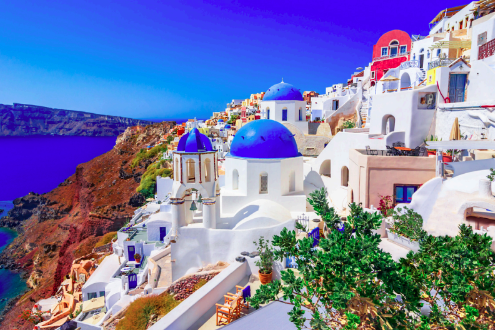Aesthetics in landscape architecture focuses on creating enjoyment, cultural significance, and personal experiences [1]. This approach helps designs better reflect the diverse materials, senses, and meanings in our surroundings. Five aesthetic dimensions in nature-based tourism—harmony, scenery/viewing, cleanliness, genuineness, and variation/contrast—influence tourists’ experiences and satisfaction [2].
Tourist destinations with unique aesthetics or identities tend to attract more visitors than those without. For example, Greece was one of the top 10 most visited countries worldwide in 2023, boasting attractions like the Acropolis in Athens, the ancient ruins of Delphi, and the stunning islands of Santorini and Mykonos, which draw millions of tourists each year [3].

Despite Greece’s economic challenges, tourism has played a crucial and positive role in boosting the country’s economy. The steady influx of visitors not only generates essential revenue but also supports local businesses and creates job opportunities, contributing significantly to Greece’s economic recovery and future growth [4].

Aesthetic Design and Sustainable Tourism
The emphasis on aesthetic design in tourism can enhance sustainability. When destinations prioritize beautiful, culturally significant, and authentic designs, they not only attract more visitors but also promote environmental stewardship and cultural preservation. By valuing and integrating the natural and cultural heritage into their design, these destinations encourage practices that protect and sustain these resources.
Integrating Aesthetic Design into Sustainable Tourism
To integrate aesthetic design into sustainable tourism, it is crucial to assess unique cultural, historical, and natural assets. However, many stakeholders in the tourism industry struggle with limited resources or a loss of cultural identity, making this process challenging. Engaging local communities in planning ensures culturally significant and authentic designs, but this can be difficult when cultural heritage has eroded. Despite the tremendous economic and socio-cultural benefits, there is often little attention and investment in conservation or the development of new strategies to preserve these assets. For example, iconic monuments like Machu Picchu, the Taj Mahal, Petra, and Angkor Wat, among many others with irreplaceable cultural heritage significance, are currently eroding at a noticeable rate [5]. Many of the United Nations’ World Heritage Sites in developing countries are in a bad state, highlighting the need for restoration and preservation programs [6]. Factors contributing to cultural heritage erosion include the abandonment of indigenous languages, traditional clothing, music, festivals, arts and crafts, work ethics, and religion in favor of foreign materials and values [7].

Educating and Promoting for Sustainable Tourism
Educating and training stakeholders on the importance of aesthetic design and sustainability is crucial for maintaining high standards. This process involves comprehensive workshops, seminars, and on-the-job training to ensure that everyone involved—from planners and architects to local business owners and tour operators—understands the value of integrating aesthetic and sustainable practices. Such education efforts need substantial support and resources, including funding for training programs, access to expert knowledge, and collaboration with educational institutions.
With well-educated and trained stakeholders, destinations can effectively market and promote their unique and sustainable features. By highlighting the harmonious blend of modern amenities, such as comfortable accommodations and high-quality infrastructure, with rich cultural heritage and educational opportunities about local culture, these destinations can attract more visitors. This enhances both the cultural and environmental value of the destination. Creating a compelling narrative that showcases these strengths helps destinations resonate with tourists worldwide. This approach not only boosts tourism but also fosters a deeper appreciation for the preservation of cultural and natural resources.
References
[1] Melcher, K. (2022). Aesthetic Intent in Landscape Architecture. Landscape Journal, 41, 73 – 92.
[2] Breiby, M. (2015). Exploring Aesthetic Dimensions in Nature-Based Tourist Experiences. Tourism Analysis, 20, 369-380.
[3] UNWTO. (2024). China recovers its position as top spender in 2023 as Asia and the Pacific reopens to tourism. https://www.unwto.org/news/
[4] Pegkas, P. (2020). Interrelationships between tourism, energy, environment and economic growth in Greece. Anatolia, 31, 565 – 576.
[5] Otero, J. (2021). Heritage Conservation Future: Where We Stand, Challenges Ahead, and a Paradigm Shift. Global Challenges, 6(1), 2100084.
[6] Tuan, T., & Navrud, S. (2007). Valuing cultural heritage in developing countries: comparing and pooling contingent valuation and choice modelling estimates. Environmental and Resource Economics, 38, 51-69.
[7] Yakubu, U. (2002). Cultural Erosion and the Crises of Development in Nigeria. The Journal of cultural studies, 4, 1-55.